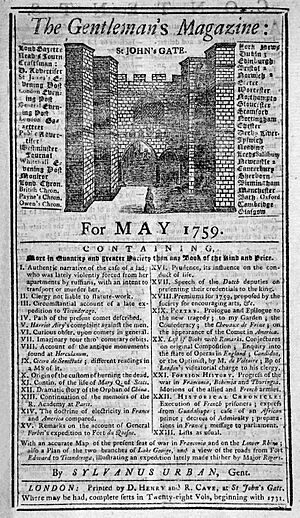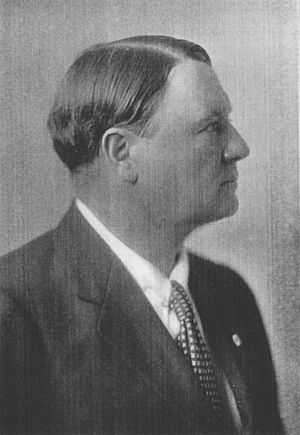History of journalism in the United Kingdom facts for kids
The history of journalism in the United Kingdom is all about how people in the UK have gathered and shared news over time. It shows how technology and trade helped news spread faster and to more people. Historians look at how much news became available and how quickly it traveled.
For a long time, newspapers were the main way journalists shared information, starting around the 1700s. Later, magazines became popular in the 1700s, followed by radio and television in the 1900s. Today, the internet is a huge part of journalism. London has always been the main hub for British journalism.
How News Started in the UK
Across Europe after the 1500s, news traveled through special letters called newsletters. These newsletters used well-known routes. Antwerp, a city in Belgium, was a central point for two big networks. One connected France, Britain, Germany, and the Netherlands. The other linked Italy, Spain, and Portugal. People loved reading about wars, military events, politics, and even royal gossip.
After 1600, governments in France and England started printing their own official newsletters. In 1622, the first English-language weekly news publication appeared. It was called "A current of General News" and was printed in England. It usually had 8 to 24 pages.
Early Rules and Royal Control
By the 1500s, printing was strictly controlled by the King or Queen. Only English subjects were allowed to print. The Crown, meaning the King or Queen, put tight rules on sharing religious or political printed materials. In 1538, Henry VIII made a rule that all printed items had to be approved by the Privy Council before they could be published. The Privy Council was a group of advisors to the monarch. By 1581, printing anything that stirred up rebellion was a crime punishable by death.
Queen Mary used the printing business itself to control it. In 1557, she gave a special permission, called a Royal Charter, to the Company of Stationers. This Company became a partner with the state under Queen Elizabeth I. They benefited a lot because this partnership limited how many printing presses existed. This meant they had less competition and could keep their business profitable. It also helped the Crown because the Company was less likely to print things that would upset their relationship with the King or Queen, as their special rights came directly from them.
Rules on printing became even stricter over time. Edward VI banned 'spoken news or rumour' in his official announcements from 1547 to 1549. You needed royal permission before any news could be published. All printed news was seen as belonging to the King or Queen.
The only type of printed news allowed was called a 'relation'. This was a story about a single event, either from the UK or from another country. These 'relations' were printed and shared for hundreds of years. They were often sold near the north door of St Paul's Cathedral. There were two main kinds of news sold there: exciting stories called 'Wonderful and Strange Newes' and government propaganda, which was information meant to promote a certain idea. The exciting news often had catchy titles to grab readers' attention.
The 1600s: Pamphlets and Freedom of the Press
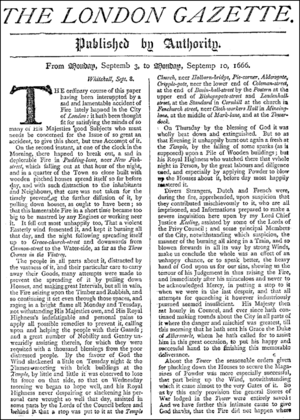
The 1600s saw a big increase in political pamphlets. These were small booklets about current issues. This happened because of the many political arguments during the bloody civil war. Each side wanted to get its supporters involved by sharing lots of pamphlets. People would often read these aloud in coffeehouses. Holland already had regular weekly news called corantos. In 1620, Holland started sending about a thousand corantos to England. The first coranto printed in England was probably by Thomas Archer in early 1621. He was later sent to prison for printing it without a license. These early news sheets were expensive and didn't sell much because people cared more about news from England than from Europe.
In 1641, two powerful courts, the Court of High Commission and the Star Chamber, were closed down. Also, copyright laws were not enforced. This meant the press was now free! Many people started printing their own newsbooks without fear of being punished. However, only a few of these publications lasted beyond their first few issues. Newsbooks during the Civil War contained information that affected everyone. They cost only a penny or twopence. Some titles sold as many as 1,500 copies.
A very important moment happened in 1694. The `Licensing Order of 1643`, which had been put in place by the Stuart kings, finally ended. This law had heavily censored news and ideas. Its end allowed writers to criticize the government freely. From 1694 until the `Stamp Act` of 1712, the only laws against printing were for treason, spreading false information about the government, or reporting on Parliament's meetings.
The 1640s and 1650s were a very fast-paced time for British journalism. Because copyright laws were gone, over 300 different news publications quickly appeared. Many didn't last, with only 33 surviving for a full year. This was also a time of war and many different opinions. Royalist newspapers supported the King, while most newsbooks in London supported Parliament. These publications often tried to make readers pick a side.
The freedom of the press ended when King Charles II returned to power in the `Restoration`. In 1662, he introduced the `Printing Act`. This law limited printing to the University of Oxford, Trinity College, Cambridge, and to master printers in London. It also said that only 20 people were allowed to work as master printers. This act brought back the strict rules that had been removed earlier.
The `Oxford Gazette` was printed in 1665 by Muddiman during the Great Plague of London. It was the first publication to truly be considered a newspaper. It was printed twice a week with the King's permission and was soon renamed `The London Gazette`. Most historians consider the `Gazette` to be the first English newspaper.
Before the `Glorious Revolution` in 1688, journalism was a risky job. For example, Benjamin Harris was punished for criticizing the King. He couldn't pay a large fine and was sent to prison. He later went to America where he started one of the first newspapers there. After the Revolution, the new King, William III, was careful about public opinion. He didn't try to stop the growing press. The growth of journalism and its increasing freedom showed a bigger change: the development of political parties. As having a parliamentary opposition became accepted, newspapers and editors started taking sides. They soon became very important in the country's politics and society.
The 1700s: Magazines and Daily News
By the early 1700s, Britain was becoming a more stable and wealthy country. Its empire was growing, and there were new technologies in industry and farming. Trade was also booming. A new group of wealthy middle-class people was emerging. These were merchants, traders, business owners, and bankers. They were educated, could read, and wanted to be part of political discussions and help run the country. This led to a huge growth in journalism, with many new newspapers and magazines. Writers who used to depend on rich sponsors could now work for themselves by writing for newspapers. The ideas in these new publications mostly matched the middle class's values. They focused on the importance of owning property, religious freedom, and freedom of thought. This was different from the strict rules in France and other countries.
London's The Gentleman's Magazine, first published in 1731, was the first magazine for general readers. Edward Cave, who edited it, was the first to use the word "magazine." He thought of it like a military storehouse filled with different kinds of information. The oldest consumer magazine still being printed is The Scots Magazine, which started in 1739. Lloyd's List began in a London coffee shop in 1734 and is still published today as a daily business newspaper.
Many great writers worked in journalism in the first half of the 1700s. These included Daniel Defoe, Jonathan Swift, Joseph Addison, Richard Steele, Henry Fielding, and Samuel Johnson. They edited newspapers or wrote essays for popular publications about important topics. Their writing was fun and informative, and ordinary middle-class people eagerly wanted to read it. These citizens were starting to join in the flow of ideas and news.
Newspapers became so popular that publishers started printing them every day. The world's first daily newspaper was the Daily Courant, started by Samuel Buckley in London in 1702. This newspaper only printed news and facts, without opinions. It avoided political problems by making money from selling advertising space.
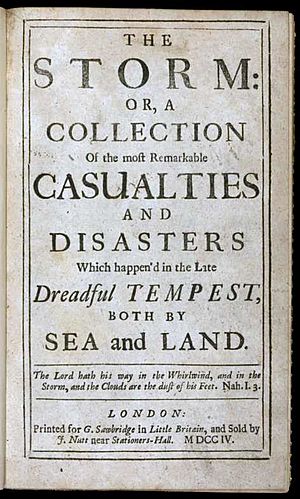
Daniel Defoe is seen as a pioneer of modern journalism. His book The Storm (1704) is considered one of the first important works of modern journalism. It's also the first detailed report of a hurricane in Britain. It describes a terrible week-long storm that hit London starting November 24, 1703. Defoe called it "The Greatest... of all the Tempests and Storms that History gives any Account of."
Defoe gathered eyewitness stories by putting ads in newspapers. He asked readers to send in their personal accounts. He chose about 60 of these and edited them for his book. This was a new way to report news at a time when journalism didn't usually rely on first-hand reports.
Richard Steele, inspired by Defoe, started The Tatler in 1709. It shared news and gossip heard in London coffeehouses. It also shared ideas about good manners for the middle class.
Jonathan Swift wrote his best satires, which are funny criticisms, for The Examiner. He often used stories with hidden meanings to make fun of the arguments between the Tories and Whigs (two political groups). The "Cato Letters," written by John Trenchard and Thomas Gordon, were published in the `London Journal` in the 1720s. These letters discussed ideas about freedom, representative government, and free speech. These letters had a big impact in colonial America and helped shape the early republican movement there.
The government didn't like how popular and influential newspapers were becoming. The first idea for a tax on newspapers came up in Parliament in 1711. The tax was finally put in place in 1712. It was a halfpenny for papers of half a sheet or less, and a penny for papers from half a sheet to a full sheet. Jonathan Swift thought that `The Spectator` newspaper wouldn't survive this tax. He was right, and it stopped printing in December 1712. However, some other newspapers kept going, and their numbers soon grew. This growth was partly because some owners had political connections. Later, in the mid-1700s, the rules and punishments of the `Stamp Act` became stricter. Yet, the number of newspapers continued to rise. In 1753, over 7 million newspaper copies were sold yearly in Britain. By 1767, this number had risen to over 11 million. In 1776, London alone had 53 newspapers.
An important person in the fight for more press freedom was John Wilkes. When John Stuart, 3rd Earl of Bute, became head of the government in 1762, Wilkes started a `radical` weekly paper called The North Briton to attack him. He used an anti-Scots tone. Wilkes was charged with `seditious libel` (printing false information that harms the government) for criticizing King George III's speech about the `Paris Peace Treaty` in 1763. Many people, including Wilkes, were arrested. However, Wilkes gained a lot of public support because he argued that the arrest warrants were against the law. A judge ruled that as a Member of Parliament, Wilkes was protected from arrest for libel. He was returned to his seat in Parliament and sued those who arrested him.
Because of this event, Wilkes became very popular. People chanted, "Wilkes, Liberty and Number 45," referring to his newspaper. However, he was later found guilty of libel again and sentenced to 22 months in prison and a £1,000 fine. Even though he was elected to Parliament three times while in prison, Parliament overturned the election results. When he was finally released in 1770, he campaigned for more press freedom. He especially defended the right of publishers to print reports of Parliament's debates. Because of strong public support, the government had to give in and stopped trying to censor the press.
The 1800s: Big Changes for Newspapers
Four main things changed newspapers in Britain during the 1800s. First, by the 1830s, the government ended very high taxes and strict legal rules on newspapers. Second, new machines, especially the rotary press, allowed printing tens of thousands of copies a day at a low cost. Third, newspapers reached new readers by adding features, pictures, and advertisements. Finally, more men were allowed to vote, and newspapers became the main way people learned about politics.
By the early 1800s, London had 52 newspapers, and there were over 100 others. Britain was at war with France, and the government wanted to stop negative rumors and harmful information. So, it tightened censorship and raised taxes. This made newspapers too expensive for most working people. However, coffeehouses often bought one or two copies that were passed around. In the 1830s, hundreds of illegal, untaxed newspapers were circulated. Most of them had very revolutionary political ideas. Their publishers were arrested, but this didn't stop them. Finally, Milner Gibson and Richard Cobden argued in Parliament to first reduce the tax in 1836 and then completely remove it in 1855. After the tax was lowered in 1836, the number of English newspapers sold went from 39 million to 122 million by 1854. This trend grew even more with better transportation and communication, and more people learning to read.
The Times Newspaper
The Daily Universal Register started in 1785 and became known as The Times in 1788. In 1817, Thomas Barnes became its main editor. He was a political radical, meaning he wanted big changes. He often criticized politicians and strongly supported freedom of the press. Under Barnes and his successor, John Thadeus Delane, The Times became very powerful, especially in politics and in London's financial district. It pushed for reforms.
Because Barnes strongly supported `Catholic Emancipation` in Ireland, his colleague Lord Lyndhurst called him "the most powerful man in the country." The Times became the first newspaper in the world to reach a huge number of readers. This was because it was one of the first to use the steam-powered rotary printing press. It was also the first truly national newspaper, using the new steam trains to deliver copies to growing cities across the UK. This helped the paper make money and become even more influential.
The Times started the practice of sending war correspondents to cover conflicts. W. H. Russell, the paper's reporter during the `Crimean War` (1853-1856), wrote very important reports. For the first time, the public could read about the real difficulties of war. For example, in September 1854, Russell wrote about a battle. He highlighted the poor medical care for wounded soldiers and the lack of ambulances. The public was shocked and angry, which led to major reforms.
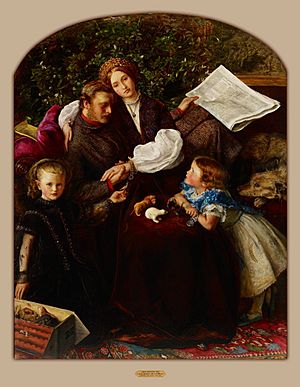
The Times became famous for its influential `leaders`, which are opinion pieces written by the editors. For example, Robert Lowe wrote them between 1851 and 1868 on many economic topics, like `free trade`, which he supported.
In 1959, journalism historian Allan Nevins explained how important The Times was in shaping the views of London's leaders: The Times has been a very important part of Britain's political system for over a century. Its news and opinions were usually carefully planned and handled with a strong sense of responsibility. While the paper included some light topics, it mostly focused on important public affairs, always thinking about what was best for Britain. To help with this, the editors often stayed in close contact with `10 Downing Street`, the Prime Minister's office.
Other Important Newspapers
The Manchester Guardian was started in Manchester in 1821 by a group of `non-conformist` businessmen (people who didn't follow the official Church of England). Its most famous editor, Charles Prestwich Scott, made the Guardian a world-famous newspaper in the 1890s. The Daily Telegraph was first published on June 29, 1855. It became the first penny newspaper in London. The Daily Telegraph became the newspaper for the middle class and had the largest number of readers in the world by 1890. It supported the Liberal Party until 1878, when it disagreed with Gladstone's foreign policy and changed its support to the Unionist party.
New Journalism for Everyone
`New Journalism` was a style that reached out not to the rich and powerful, but to everyday people. A very important person in this movement was William Thomas Stead. He was a controversial journalist and editor who helped create `investigative journalism`, where reporters deeply research a topic. Stead's 'new journalism' helped lead to the modern `tabloid` newspaper style. He showed how the press could influence public opinion and government decisions. He even suggested "government by journalism." He was also known for his reports on child welfare, social laws, and changes to England's criminal laws.
Stead became assistant editor of the Liberal Pall Mall Gazette in 1880. He worked to change this newspaper, which was traditionally "written by gentlemen for gentlemen." Over the next seven years, Stead developed what Matthew Arnold called 'The New Journalism'. As editor of the Gazette, he made newspapers more exciting. He was the first to use maps and diagrams in a newspaper. He broke up long articles with eye-catching subheadings. He also mixed his own opinions with those of the people he interviewed. He made special 'Pall Mall' extras, and his energy and original ideas had a strong impact on journalism and politics at the time. Stead's first big campaign was based on a pamphlet called "The Bitter Cry of Outcast London." His shocking stories about terrible living conditions pushed the government to clear slums and build affordable housing. He also introduced the interview, creating a new way of reporting in British journalism when he interviewed General Gordon in 1884. He used sensational headlines, like when Gordon died in Khartoum in 1885. He ran the first 24-point headline in newspaper history, "TOO LATE!", showing his sadness that the rescue team failed to save a national hero. He is also known for starting the modern idea of creating a news event, not just reporting on it, with his famous investigation into the `Eliza Armstrong case`.
Matthew Arnold, a leading critic, said in 1887 that the New Journalism "is full of ability, novelty, variety, sensation, sympathy, generous instincts." However, he added that its "one great fault is that it is feather-brained," meaning it lacked serious thought.
A pioneer of popular journalism for the working class was the `Chartist` newspaper Northern Star, first published in 1838. Around the same time, the first cheap newspaper was the Daily Telegraph and Courier (1855), later known simply as the Daily Telegraph. The Illustrated London News, founded in 1842, was the world's first illustrated weekly newspaper.
The period from 1860 to about 1910 is seen as a 'golden age' for newspapers. This was due to new printing and communication technologies, journalists becoming more professional, and new powerful newspaper owners.
The 1900s: Rise of Popular Newspapers
The start of the 1900s saw the rise of popular journalism aimed at the working class. These papers often focused on exciting or shocking topics. Alfred Harmsworth, Lord Northcliffe (1865–1922), was the main innovator. He greatly shaped the modern press. He introduced or used ideas that are still central today: wide range of content, using advertising money to keep prices low, aggressive marketing, and being independent from political parties. In 1896, he started publishing the Daily Mail in London. It was a huge success and held the world record for daily sales until Northcliffe's death. Its slogans included "the busy man's daily journal" and "the penny newspaper for one halfpenny." Prime Minister Lord Salisbury joked that it was "written by office boys for office boys." Northcliffe used his newspapers' new influence. In 1899, he successfully asked for donations for the families of soldiers fighting in the `South African War`. He even asked Rudyard Kipling and Arthur Sullivan to write a song called The Absent-Minded Beggar for the cause.
Socialist and labor newspapers also grew. In 1912, the Daily Herald was launched as the first daily newspaper for the `trade union` and labor movement.
Newspapers were most important during the First World War. This was partly because wartime issues were so urgent and newsworthy. Also, Members of Parliament couldn't criticize the government much because of the all-party coalition government. By 1914, Northcliffe controlled 40% of morning newspaper sales in Britain, 45% of evening sales, and 15% of Sunday sales. He eagerly tried to turn this into political power, especially by attacking the government during the `Shell Crisis of 1915`. Lord Beaverbrook said Northcliffe was "the greatest figure who ever strode down Fleet Street" (a famous street for newspapers in London).
Other powerful editors included C. P. Scott of the Manchester Guardian, James Louis Garvin of The Observer, and Henry William Massingham of the influential weekly magazine The Nation.
21st Century Journalism
Journalism expert Adrian Bingham notes that newspaper journalists are sometimes not highly trusted. He mentions a poll where the trustworthiness of journalists from papers like The Sun, Mirror, and Daily Star was very low. Only 7% of people said they could be trusted to tell the truth. However, television journalists scored much higher at 49%. Bingham lists some common complaints about the press.
He also states that, in his view, there are serious problems: The three main areas where the press can be criticized are:
- Not representing and respecting the diverse people of modern Britain.
- Caring more about speed and immediate impact than about being accurate and reliable.
- Being unwilling to accept and think about the social responsibilities that come with popular journalism.


